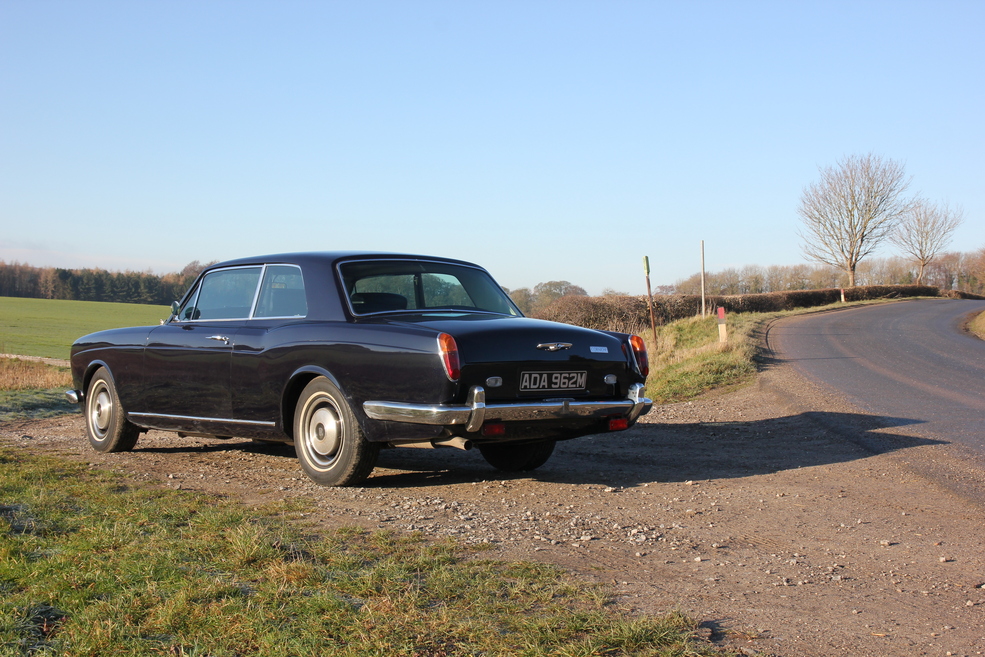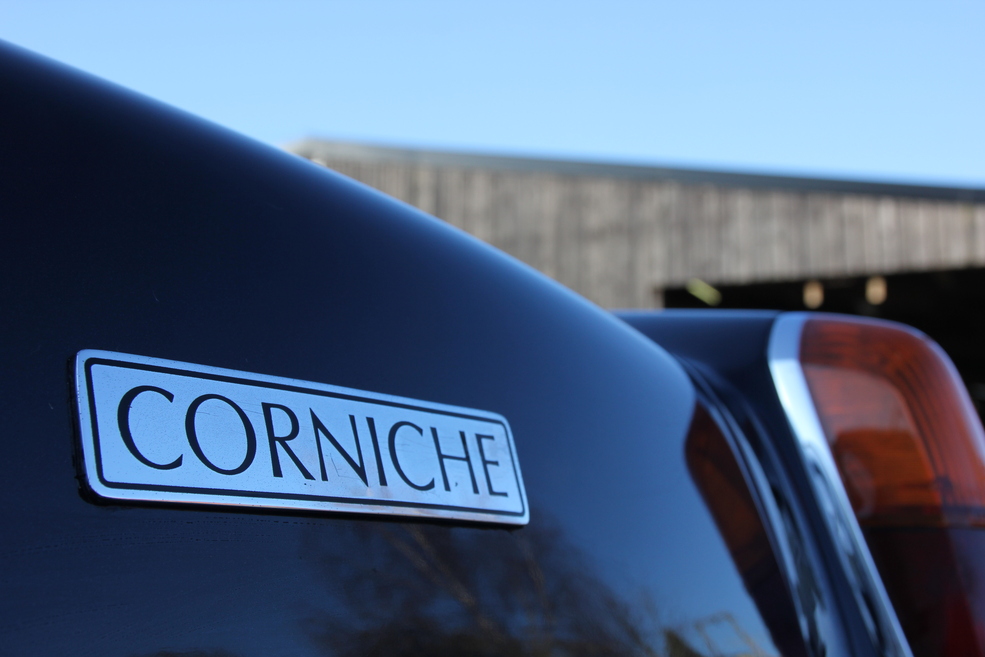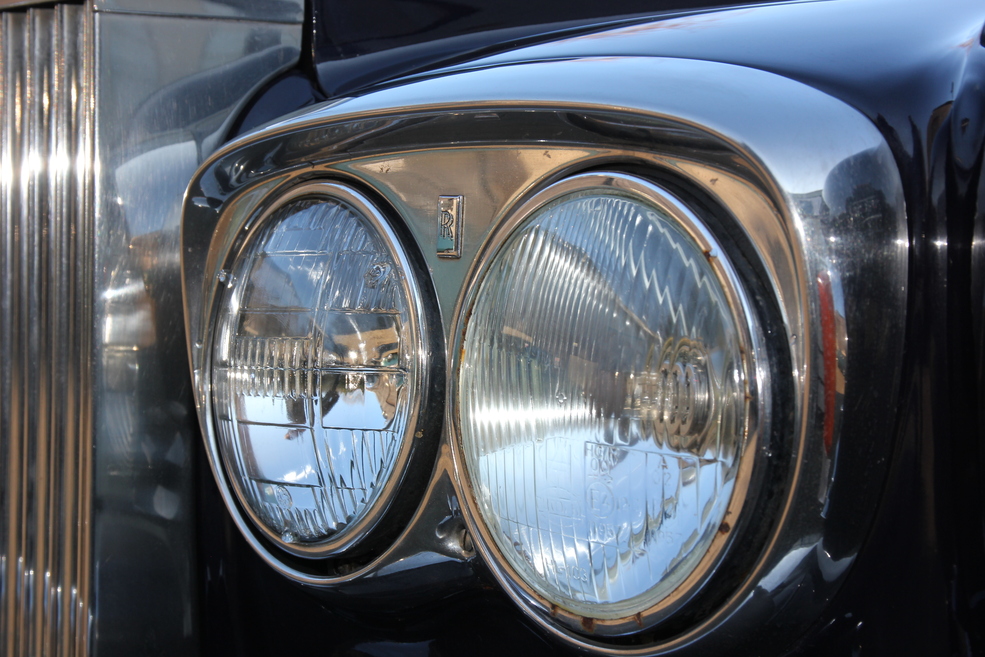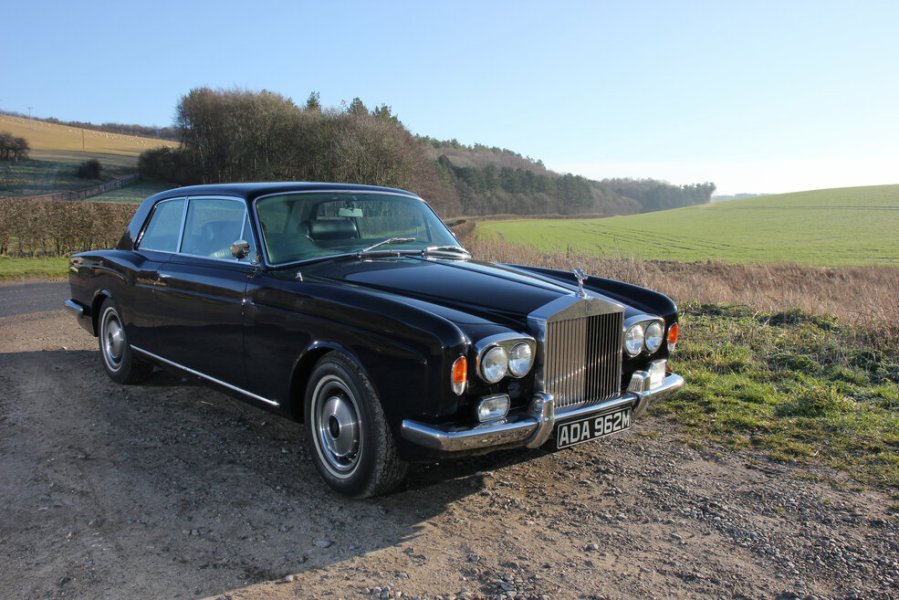Timelessly stylish and still luxurious, the Silver Shadow’s two-door sibling is a fine classic choice. Here’s how to buy a Corniche today
Sponsored editorial in association with Lancaster Insurance
In March 1971, the coachbuilt two-door cabriolet and coupé versions of the Rolls-Royce Silver Shadow – which bore dauntingly long titles such as the Rolls-Royce Silver Shadow Mulliner Park Ward Drophead Coupé – were replaced by a new model carrying the far more evocative Corniche name. Derived from the French word for a road cut into the side of a cliff or mountain, particularly those along the Riviera, it was a perfectly fitting moniker for a glamorous two-door Rolls-Royce. The range was rebranded as the Corniche Saloon and Corniche Convertible.
Alongside the new name came subtle cosmetic revisions: the radiator shell was deepened and slightly raked forward to give the car a more imposing frontal appearance, while the dashboard was redesigned to incorporate an exclusive set of auxiliary dials and a tachometer. A wood-rimmed steering wheel and standard-fit driving lamps added to the sporting flavour. Cruise control also became available as an option. At launch, the Corniche Saloon was priced at £12,829, with the Convertible carrying a £600 premium – enough, at the time, to buy two suburban semis or a Lamborghini Miura with change for a Mini Cooper runabout.
In 1972, suspension was upgraded to ‘compliant’ specification, with improved bushings that enhanced ride comfort and further reduced road noise. Standard-fit radial tyres and ventilated front discs were also introduced. By 1974, the wheelbase had been extended fractionally to 120 inches, while wider wheels and tyres increased the track, necessitating subtly flared arches. A year later, electronic ignition became standard, improving reliability and reducing service demands.

The Series II Silver Shadow arrived in 1977, and although the Corniche did not take on the designation, it benefited from many of the same upgrades. These included deeper polished alloy bumpers with rubber cladding, a front air dam, and the adoption of the Camargue’s advanced twin-zone climate control. Inside, a new asymmetric fascia was fitted, while under the skin came rack-and-pinion steering and revised suspension geometry. Handling improved markedly, though at the expense of a fraction of the model’s legendary ride quality.
In 1979, the Corniche received unique changes to its rear suspension, serving as a test bed for the forthcoming Silver Spirit. New gas struts, revised trailing arm geometry, and alterations to the springs and wheelbase (now officially 120.5 inches) brought noticeable gains in both ride and handling. By 1980, however, prices had soared: over £63,000, or around three times the average UK house price. That year also saw the Corniche Saloon dropped after just 1,108 examples, leaving the Convertible as the sole survivor.
The Corniche II finally arrived in 1988 (having been sold in the US since 1986). Changes were largely cosmetic – redesigned seats, colour-coded bumpers and mirrors, and new wheel trims – though mechanical upgrades included electronic fuel injection and ABS.
Because the Silver Spirit was essentially a heavily updated Silver Shadow, the Corniche adopted many of its innovations. The Corniche III, launched in 1990, gained the Spirit II’s Automatic Ride Control system, adjusting suspension behaviour for optimum comfort or handling depending on conditions. Other upgrades included Motronic fuel injection, a catalytic converter, inlaid woodwork, updated instruments with a trip computer, memory seats, airbags, and a premium ten-speaker audio system.
The Corniche IV followed in 1992. With Mulliner Park Ward’s Willesden works closed, production shifted entirely to Crewe. These cars gained yet another seat design, an improved version of the Ride Control system (defaulting to a softer setting), a four-speed automatic gearbox, and a heated glass rear window for the hood. Twenty-five 25th Anniversary editions were also built, all finished in Ming Blue with cream hoods, unique trim, and numbered plaques, priced at a staggering £165,270.
Production drew to a close in 1995 with the Corniche S – 25 final cars powered by the turbocharged 6.75-litre Bentley V8 producing 300bhp, complemented by upgraded suspension and steering. In total, 3,239 Corniche Convertibles were built over 24 years, securing the model’s place as one of the most glamorous and enduring cars in the Rolls-Royce story.

Rolls-Royce Corniche values
Rolls-Royce Corniche values vary widely depending on condition and body style. Fixed-head coupés are generally more affordable, with project cars starting around £15,000-£20,000, though restoration costs can quickly eclipse purchase price. Usable, presentable examples tend to command £30,000-£45,000, while the very best coupés may nudge £60,000. Convertibles, always more desirable, fetch a premium: rough projects rarely dip below £25,000, while tidy, usable cars typically fall into the £50,000-£70,000 range. The finest, low-mileage or exceptionally restored Corniche Convertibles can exceed £100,000. Try to balance glamour against upkeep, as maintenance costs remain firmly in Rolls-Royce territory regardless of purchase price…
Insurance Costs
1969 Rolls-Royce Corniche FHC, £40,000 value.
Example quote: £178.00 or £196.00 with Agreed Value.Quotation supplied by Lancaster Insurance. Tel: 01480 400761
Quote based on a 45-year-old marketing manager, access to another car, no claims or convictions, club member, 3000 miles per year, no modifications, living in SP2 0HL. Disclaimer: Subject to underwriting criteria. An additional charge may be payable. Authorised and regulated by the Financial Conduct Authority.
Bodywork
Corrosion is the real danger when buying a Corniche, even among cars in the upper half of the price range. Inspect the entire lower body carefully from nose to tail – front valance (particularly if obscured by a later chin spoiler), front arches, the rear of the front wings, the sills along their full length, the rear wheelarches and the rear valance. With the exception of the sills (especially critical on convertibles) and the area where the front wings meet the bulkhead, rust in these places can usually be regarded as cosmetic – provided you are confident it hasn’t progressed further and the structure remains sound. Repair panels are relatively inexpensive (sills around £160 per side, arches £110–180 each), but fitting and painting them properly is a costly exercise. Still, if corrosion is confined to these areas, it may be worth undertaking, so long as the car is priced accordingly and the rest of it is solid.
Rust in the rear of the front wings, the front floors, the base of the windscreen pillars or the boot floor points to more serious corrosion. Rectifying these areas demands significant work and effectively places the car into project territory – with the price reflecting that status.
Another known weak spot is the rear spring seats, which on cars of this age are prone to rusting out, potentially leading to sudden and alarming rear-end collapse. Many Corniches will already have been patched here; this is reassuring so long as the repairs have been carried out to a high standard. On convertibles, check the hood well from both sides as carefully as possible. This is an awkward and costly area to restore if corrosion has set in due to blocked drains.

Check the entire body for signs of repairs done with more of an eye on budget than quality – many a superficially pretty Corniche is riddled with filler. Look for misaligned panels from repaired dents or scrapes or areas given a sub-par respray.
Examine the body for evidence of repairs prioritising budget over quality. A Corniche that looks pristine from a distance can hide a great deal of filler. Watch for misaligned panels, poorly repaired dents or scrapes, and areas with low-quality resprays. Replacement panels are ruinously expensive – especially rear wings, which cost in excess of £2400 each – and they must then be hand-fitted, primed, loaded and painted to match the rest of the bodywork, often costing as much again as the panel itself.
Many examples will have been resprayed at some point to freshen them up, but few have been refinished to Rolls-Royce standards. A factory Crewe paintjob should be deep, even and lustrous, and you should avoid paying over the odds for a sub-standard repaint. That said, good-quality paintwork – even if not quite to original standards – may be perfectly acceptable if the rest of the car is strong and the finish is reflected in the asking price.
Brightwork is another costly area. Chrome and other fittings are expensive to refurbish or replace, so you’ll want these in the best possible condition. The doors, bonnet and bootlid are aluminium, which introduces the risk of electrolytic corrosion. This is mainly cosmetic but does spoil the appearance, and rectification is costly. New door skins are now unobtainable other than as eye-wateringly expensive new-old stock.
Convertible hoods were originally made from Everflex, which deteriorates over time. Look for splits, cracks, tears, or signs of the multiple layers coming apart. Most cars feature plastic rear windows, which should not be opaque or split. Many Corniches have been upgraded with mohair hoods, which are a desirable improvement. Expect to pay around £500 for a new Everflex hood and £800 for mohair, plus fitting. Finally, ensure the hood mechanism and cover operate smoothly, as repairs here are another major expense.

Engine and transmission
Since the Corniche shares all its major mechanical components with the Silver Shadow, it’s no surprise that the same principles apply when assessing one. These cars were engineered to cover high mileages on a regular basis with remarkably little maintenance – a philosophy made possible by the exceptional quality of their design, materials, and construction. However, this only holds true if that maintenance has been carried out properly, thoroughly, and at the correct intervals. A service should mean exactly that – not just the occasional ‘oil and filter’ change. Treated with the right degree of care, the Corniche is mechanically very robust; but when neglected, its composure soon begins to falter. Outright failures are rare, as even poorly maintained cars will keep going, but the driving experience will be a shadow of that offered by a well-looked-after example. Proper upkeep also pays huge dividends in keeping irritating glitches, snags, and upsets to a minimum.
A comprehensive service history is essential. This may come in the form of invoices from a reputable Rolls-Royce specialist or receipts for quality parts supplied to a capable DIYer. Cars with little or no evidence of consistent servicing should be approached with extreme caution and are best avoided altogether, especially when better examples exist.
Before starting the engine, check the condition of the oil and coolant, and look for any signs of head gasket failure. A good engine should run smoothly and almost silently. If the valvetrain doesn’t quieten down within 30 seconds of start-up, the hydraulic tappets are likely worn and will require replacement – expect around £1500 for a set. Knocks, rattles, excessive crankcase pressure, or blue exhaust smoke suggest the need for a full rebuild, which is possible but prohibitively expensive. Uneven running or misfiring is often due to life-expired ignition components or issues within the carburettors/fuel injection system; these are relatively easy to address but point to a lack of proper care.
The GM automatic gearboxes fitted to these cars are extremely reliable, straightforward to rebuild, and well supported for parts. Provided the unit operates without unpleasant noises, a rebuild should not be feared in the context of an otherwise strong car. The transmission fluid should be clean and clear, while the gearchanges themselves ought to be near-imperceptible. Higher-mileage units, or those overdue for a fluid change, tend to feel grabby. Many gearbox troubles are actually electrical in nature, usually stemming from the selector mechanism, where lack of use leads to poor switch connections. Test all gear positions to confirm they function correctly.
Elsewhere in the drivetrain, no common weaknesses are typically found. That said, any intrusive noise or vibration is always a red flag. Juddering under way is usually the result of seized or poorly balanced driveshaft joints, and should not be ignored.

Suspension, steering and brakes
Although the Corniche uses a Citroën-style hydropneumatic system, this is employed only for self-levelling (and for ride control on later examples), with conventional steel springs doing the real work. As a result, a Corniche will not ‘sink’ when left standing. A noticeably jiggly ride on the move is another tell-tale symptom of the same issue. Replacement spheres cost around £40 each, and fitting is a straightforward job for any Rolls-Royce or Citroën specialist – usually, the latter proves the more cost-effective option.
Later models equipped with Automatic Ride Control (ARC) can also suffer from a stiff-legged ride if the system is faulty. The difficulty lies in distinguishing whether the culprit is the ARC itself – very costly and sometimes impossible to repair – or the far cheaper spheres. Some Corniche IIIs and IVs will have had ARC removed and replaced with the earlier, simpler setup, which offers peace of mind at the expense of originality. If the rear sits low and refuses to rise with the engine running, the self-levelling system is at fault. This can lead to thousands of pounds in fault-finding and rectification, making such cars best avoided.
Steering ball joints wear quickly on these heavy cars, so check for wandering or wobbling through the wheels and listen for knocking sounds from the front end when driving over bumps. The same caution applies to the rear suspension bushes. In addition, listen for rumbles or whining noises from the wheel bearings, particularly when cornering.
The centralised hydraulic system powers the suspension, steering and brakes, so fluid cleanliness is critical. Early cars use LHS (similar to brake fluid), while later models run on LHM mineral oil. Brakes should feel sharp and very powerful. Scored or warped discs and worn pads are simple to replace, but problems with the hydraulics themselves – leaks, groaning noises, knocks through the brake pedal or warning lights on the dashboard – demand specialist attention. An overhaul of the system can run into several thousand pounds.
Interior, trim and electrics
For many would-be owners, much of the Corniche’s appeal – as with any Rolls-Royce – lies in the interior. Entirely hand-crafted, it may not be brimming with gadgets and gizmos, but the quality of materials and the standard of fit are exemplary. This has long defined Rolls-Royce luxury: timeless craftsmanship rather than fleeting technology. Built using traditional methods and materials, almost everything in a Corniche cabin can be repaired, refurbished or replaced – but such craftsmanship and premium materials never come cheaply.
As with the exterior, it is unrealistic to think you can buy a shabby Corniche and restore it to perfection on a shoestring. For much of the model’s production, the interior differed significantly from the standard Silver Shadow, with its own design, materials and equipment. As a result, many fascia and trim components are unique to the Corniche, making them not only hard to source but also eye-wateringly expensive.
Pay close attention to the woodwork: cracked, peeling or delaminated veneer panels are common issues. Likewise, inspect the leather for scuffs, tears or general wear. Ensure all seat adjustments function properly, including fore-and-aft movement, recline angles and the folding mechanism for rear-seat access. If the seats fail to tip or latch as they should, new internals will be required – a costly undertaking. On later cars with seat memory, the electronic control units add further complexity and expense, with replacements proving particularly dear if faulty.

Rolls-Royce Corniche: our verdict
Effortlessly stylish and massively luxurious, the Corniche is as attractive a proposition as it ever was and perhaps one of the finest classic two-door coupes available. It’s not exactly sporty (you’ll need a BMW E9 or Jaguar XJ-S for a dash of driver engagement) but its strengths lie in quiet, relaxed cruising and cutting a dash in all situations.
Values are robust when compared to its four-door sibling but the good news is that a good Corniche shouldn’t be much more expensive to run, with parts and specialist support for its 6.75-litre engine and overengineered mechanicals still strong in the UK decades after its arrival. If you’ve got the funds, we’d highly recommend the classic Rolls-Royce experience.
Rolls-Royce Corniche timeline
1965
Two-door Silver Shadow coupe and convertible launched by Mulliner Park Ward (pre-Corniche)
1971
Corniche name introduced for coupe and convertible versions
1977
Corniche II launched with rubber bumpers, new grilles and safety updates
1989
Corniche III unveiled with colour-coded bumpers, fuel injection and improved interior trim
1993
Corniche IV introduced; glass rear window, electric roof and airbags as standard
1995
Coupe version discontinued; only convertible remains
2000
Silver Seraph-based Corniche 5 replaces Shadow-based models




